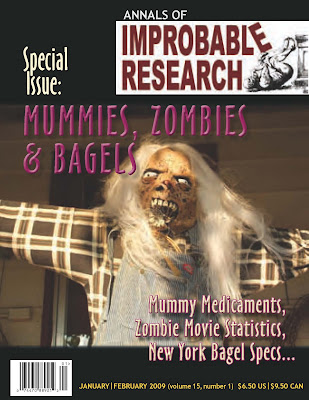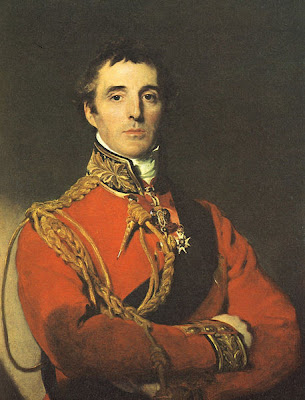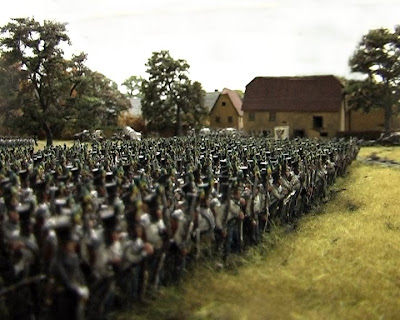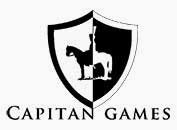 Improbable Research is research that makes people laugh and then think.
Improbable Research is research that makes people laugh and then think.
Improbable Research is the name of an organization, that collect improbable research. They publish a magazine called the Annals of Improbable Research, and they are also the administer of the Ig Nobel Prizes. Their goal is to make people laugh, then make them think. They also want to spur the people's curiosity, and to raise the question: How do you decide what's important and what's not, and what's real and what's not — in science and everywhere else?
See the list of the 2008 Ig Nobel Prize Winners
NUTRITION PRIZE. Massimiliano Zampini of the University of Trento, Italy and Charles Spence of Oxford University, UK, for electronically modifying the sound of a potato chip to make the person chewing the chip believe it to be crisper and fresher than it really is.REFERENCE: "The Role of Auditory Cues in Modulating the Perceived Crispness and Staleness of Potato Chips," Massimiliano Zampini and Charles Spence, Journal of Sensory Studies, vol. 19, October 2004, pp. 347-63.
PEACE PRIZE. The Swiss Federal Ethics Committee on Non-Human Biotechnology (ECNH) and the citizens of Switzerland for adopting the legal principle that plants have dignity. REFERENCE: "The Dignity of Living Beings With Regard to Plants. Moral Consideration of Plants for Their Own Sake".
ARCHAEOLOGY PRIZE. Astolfo G. Mello Araujo and José Carlos Marcelino of Universidade de São Paulo, Brazil, for measuring how the course of history, or at least the contents of an archaeological dig site, can be scrambled by the actions of a live armadillo.REFERENCE: "The Role of Armadillos in the Movement of Archaeological Materials: An Experimental Approach," Astolfo G. Mello Araujo and José Carlos Marcelino, Geoarchaeology, vol. 18, no. 4, April 2003, pp. 433-60.
BIOLOGY PRIZE. Marie-Christine Cadiergues, Christel Joubert, and Michel Franc of Ecole Nationale Veterinaire de Toulouse, France for discovering that the fleas that live on a dog can jump higher than the fleas that live on a cat.REFERENCE: "A Comparison of Jump Performances of the Dog Flea, Ctenocephalides canis (Curtis, 1826) and the Cat Flea, Ctenocephalides felis felis (Bouche, 1835)," M.C. Cadiergues, C. Joubert, and M. Franc, Veterinary Parasitology, vol. 92, no. 3, October 1, 2000, pp. 239-41.
MEDICINE PRIZE. Dan Ariely of Duke University (USA), Rebecca L. Waber of MIT (USA), Baba Shiv of Stanford University (USA), and Ziv Carmon of INSEAD (Singapore) for demonstrating that high-priced fake medicine is more effective than low-priced fake medicine..REFERENCE: "Commercial Features of Placebo and Therapeutic Efficacy," Rebecca L. Waber; Baba Shiv; Ziv Carmon; Dan Ariely, Journal of the American Medical Association, March 5, 2008; 299: 1016-1017.
COGNITIVE SCIENCE PRIZE. Toshiyuki Nakagaki of Hokkaido University, Japan, Hiroyasu Yamada of Nagoya, Japan, Ryo Kobayashi of Hiroshima University, Atsushi Tero of Presto JST, Akio Ishiguro of Tohoku University, and Ágotá Tóth of the University of Szeged, Hungary, for discovering that slime molds can solve puzzles. REFERENCE: "Intelligence: Maze-Solving by an Amoeboid Organism," Toshiyuki Nakagaki, Hiroyasu Yamada, and Ágota Tóth, Nature, vol. 407, September 2000, p. 470.
ECONOMICS PRIZE. Geoffrey Miller, Joshua Tybur and Brent Jordan of the University of New Mexico, USA, for discovering that professional lap dancers earn higher tips when they are ovulating. REFERENCE: "Ovulatory Cycle Effects on Tip Earnings by Lap Dancers: Economic Evidence for Human Estrus?" Geoffrey Miller, Joshua M. Tybur, Brent D. Jordan, Evolution and Human Behavior, vol. 28, 2007, pp. 375-81.
PHYSICS PRIZE. Dorian Raymer of the Ocean Observatories Initiative at Scripps Institution of Oceanography, USA, and Douglas Smith of the University of California, San Diego, USA, for proving mathematically that heaps of string or hair or almost anything else will inevitably tangle themselves up in knots.REFERENCE: "Spontaneous Knotting of an Agitated String," Dorian M. Raymer and Douglas E. Smith, Proceedings of the National Academy of Sciences, vol. 104, no. 42, October 16, 2007, pp. 16432-7.
CHEMISTRY PRIZE. Sharee A. Umpierre of the University of Puerto Rico, Joseph A. Hill of The Fertility Centers of New England (USA), Deborah J. Anderson of Boston University School of Medicine and Harvard Medical School (USA), for discovering that Coca-Cola is an effective spermicide, and to Chuang-Ye Hong of Taipei Medical University (Taiwan), C.C. Shieh, P. Wu, and B.N. Chiang (all of Taiwan) for discovering that it is not.REFERENCE: "Effect of 'Coke' on Sperm Motility," Sharee A. Umpierre, Joseph A. Hill, and Deborah J. Anderson, New England Journal of Medicine, 1985, vol. 313, no. 21, p. 1351.REFERENCE: "The Spermicidal Potency of Coca-Cola and Pepsi-Cola," C.Y. Hong, C.C. Shieh, P. Wu, and B.N. Chiang, Human Toxicology, vol. 6, no. 5, September 1987, pp. 395-6. [NOTE: THE JOURNAL LATER CHANGED ITS NAME. NOW CALLED "Human & experimental toxicology"]
LITERATURE PRIZE. David Sims of Cass Business School. London, UK, for his lovingly written study "You Bastard: A Narrative Exploration of the Experience of Indignation within Organizations."REFERENCE: "You Bastard: A Narrative Exploration of the Experience of Indignation within Organizations," David Sims, Organization Studies, vol. 26, no. 11, 2005, pp. 1625-40.
Follow them at Improbable Research



 Enjoy his BIG squadrons!
Enjoy his BIG squadrons!




















































